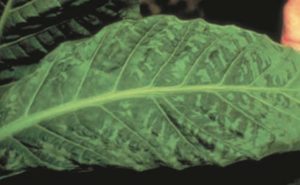

By Gertrud U. Rey
Post-transcriptional gene silencing (PTGS) is an RNA regulation pathway in eukaryotes that depends on the presence of double stranded RNA (dsRNA) in the cytoplasm of cells. As stated by Nels Elde in TWiEVO 8, dsRNA in the cytoplasm has an effect synonymous to “blood in the water” for the innate immune system, triggering a cascade of events that leads to the degradation of complementary mRNAs. In plants, this pathway has been thought to serve as the predominant mechanism of antiviral defense.
Gene silencing mechanisms primarily target native transcripts that are defective, or foreign transcripts that may or may not originate from viral infection. PTGS consists of two main mechanisms, both of which are prompted by the presence of dsRNA molecules, such as small interfering RNAs (siRNAs). In inverted-repeat post-transcriptional gene silencing, dsRNA is formed when a single transcript folds back upon itself to prevent its hybridization to “good” mRNAs. In sense PTGS (S-PTGS), single stranded RNA has to first be converted into dsRNA by host RNA-dependent RNA polymerase to trigger PTGS. Viral mechanisms counter both of these mechanisms by use of suppressors of RNA silencing, which inhibit host antiviral responses by interacting with the key components of the cellular silencing machinery.
There is increasing evidence to suggest that the eukaryotic RNA decay machinery is just as important in cellular antiviral defense as PTGS. In the RNA decay pathway, cytoplasmic mRNA molecules are enzymatically degraded in a 5′ to 3′ and 3′ to 5′ exoribonuclease-dependent mechanism. This mechanism can be initiated by deadenylation (removal of the 3′ poly(A) tail), followed by 3′ to 5′ degradation of the RNA molecule; or by decapping (removal of the mRNA 5′ cap), followed by 5′ to 3′ degradation. These activities typically take place in specialized cytoplasmic aggregates known as P-bodies following the accumulation of key eukaryotic cytoplasmic RNA decay factors such as DCP1, DCP2, PARN, and XRN4. DCP1 and DCP2 are decapping proteins that form a complex that facilitates removal of the mRNA 5′ cap. PARN is a poly(A)-specific ribonuclease that catalyzes deadenylation of the mRNA and XRN4 is an exoribonuclease that effects that actual degradation of the decapped or deadenylated RNA molecule. Several studies have shown that knockout of the genes coding for these crucial RNA decay pathway proteins boosts viral infection and promotes the accumulation of viral RNA in infected cells. Conversely, viruses deal with this attack by repressing key steps in the RNA decay pathway, thereby preventing degradation of viral RNA and promoting viral infection.
A recently published study sought to clarify whether the relationship between the PTGS and RNA decay pathways is of competitive or collaborative nature. Using Nicotiana benthamiana and Arabidopsis thaliana as plant model organisms, the investigators analyzed the interactions between DCP1, DCP2, PARN, XRN4, and key viral suppressors of RNA silencing following infection of the plants with turnip mosaic virus (TuMV).
Here are the key findings:
- Overproduction of DCP1, DCP2, PARN, and XRN4 in plants does not suppress S-PTGS and production of siRNAs induced by foreign transcripts, but instead enhances S-PTGS. This observation suggests that the RNA decay pathway plays an additive role in S-PTGS.
- The absence of DCP1, DCP2, PARN, and XRN4 in knock-down experiments impairs S-PTGS and suppresses the generation of siRNAs induced by viruses. This environment leads to an increase in viral infection and accumulation of viral RNA in infected plants.
- When the S-PTGS pathway is disabled (in RNA-dependent RNA polymerase deficient plants), DCP1, DCP2, PARN, and XRN4 degrade foreign transcripts via the RNA decay pathway. This result suggests that the RNA decay pathway is functional when RNA silencing is compromised.
- VPg and HC-Pro, two known TuMV suppressors of RNA silencing bind DCP2 and XRN4, respectively, thereby compromising their antiviral functions.
Based on these results, the authors present a virus-host interaction model featuring the RNA silencing and RNA decay pathways. The model proposes that upon entry into the cytoplasm, TuMV genomic RNA is deadenylated or decapped to initiate 3′-5′ or 5′-3′ degradation. Following degradation by XRN4, the resulting single-stranded RNA is converted to dsRNA by RNA-dependent RNA-polymerase, and enters the S-PTGS pathway. In counteracting this antiviral defense mechanism, binding of VPg to DCP2 prevents formation of the DCP1/DCP2 complex, which in turn inhibits decapping of viral RNA. As a further obstruction in the RNA decay pathway, binding of HC-Pro to XRN4 inhibits degradation of RNA.
This study highlights the complexity of plant immune responses as well as the intricate interactions between viruses and the plant cells they infect. RNA silencing and RNA decay are two defense mechanisms that seem to collaborate rather than compete in defending the plant cell against viral infection.
Why do we care about how plants respond to viral infection? As discussed by Anne Simon on TWiV 512, viruses can have devastating effects on agricultural crops and the food industry. Understanding the mechanisms of antiviral defense in plants can aid in the development of improved agricultural practices.

Pingback: Viral Defenses In Plantae - Vetmedics
Pingback: Viral Defenses In Plantae – Virology